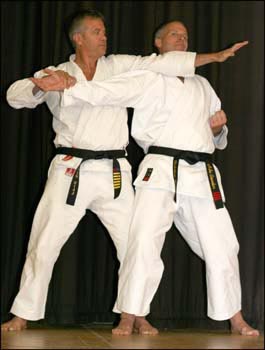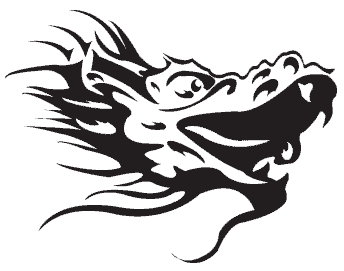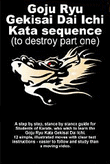Gekisai Dai Ichi & Di Ni Kata
("Attack & smash the fortress I & II or 'To destroy', to defeat by smashing or demolishing)
Gekisai dai ichi was developed by Chojun Miyagi in 1940 as a form of physical exercise for high school boys in 1948. At the end of World War Two, Miyagi Sensei began to teach the Gekisai Kata in depth as a regular part of Goju Ryu in his own Dojo. Until this time, Sanchin was usually the first Kata taught in Goju Ryu. At the time, he and Shorin master Shoshin Nagamine decided to develop basic Kata for the popularisation of Karate with school children and to help popularize Goju Ryu among the Okinawa Public. Miyagi's Kata helped fill the need for a reasonably simple, easy to learn but effective Kata with the potential required for effective self defence.
The Chinese Kanji character for "Geki" means to defeat and the Kanji character "Sai" means to 'smash or demolish' or 'attack & destroy' Sometimes described in English as 'To Destroy part 1' Dai ichi & Dai ni mean No. 1 & No 2 respectively. The Gekisai Kata contain powerful, basic movements that are reasonably easy to learn and interpret. Many of the Kata techniques have multiple applications (Bunkai). Gekisai dai ichi employs techniques clearly taken from the more advanced Goju Kata and developed into more basic form.
This Kata, as with all Kata, begin with a defensive move - The Japanese phrase: Karate ni sente nashi means "There is no first attack in Karate" or "There is no first strike in Karate"
Gekisai Kata can also be done with a partner as a 'Gi' or Combat sequence. Called 'Gekisai Gi'.
This work has been created by Tom Hill Chief Instructor GoJu.co.uk It is my understanding and interpretation of the Kata I was taught over 35 years ago by my Instructor Tony Christian 8th Dan and his Sensei of the time Master Terou Chinen.
I take full responsibility for any errors or emissions. Different Clubs, Karateka and Styles interpret this Kata in different ways. They are not wrong - just different. This is our version.
"Let me first say that I was not named the successor of goju-ryu by Miyagi, but nor was anyone else. There are some goju-ryu teachers who claim to have been privately appointed successor by Miyagi. These claims are ludicrous and disrespectful of his memory. He never publicly named anyone as successor. Common sense would dictate that if he were to appoint someone, it would have been a longtime student and it would have to be of public record to have any value. Miyagi was not a man to do things in a haphazard manner - everything was very deliberate and precise. It would also be logical to assume that since Miyagi would not grant dan ranking, how then would he be inclined to name a successor? I feel Miyagi would be rolling in his grave with the plethora of ridiculous claims about this matter."
- Seikichi Toguchi

Chojun Miyagi (Miyagi Chojun), April 25, 1888 to October 8, 1953
Rank Soke, Founder of Goju-ryu





Warning:
If you perform any technique shown here in class or in public, you do so at your own risk.
We assume no responsibility for the use or misuse of the information provided which results in injury or loss.
Copyright: Tom Hill 2012 Goju.co.uk All rights reserved.
UPDATED 21 FEB 2013



























